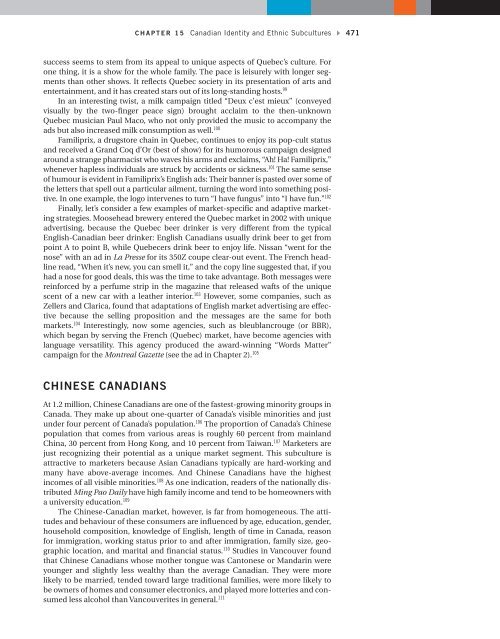Canadian Identity and Ethnic Subcultures - Pearson Canada
Canadian Identity and Ethnic Subcultures - Pearson Canada
Canadian Identity and Ethnic Subcultures - Pearson Canada
You also want an ePaper? Increase the reach of your titles
YUMPU automatically turns print PDFs into web optimized ePapers that Google loves.
CHAPTER 15 <strong>Canadian</strong> <strong>Identity</strong> <strong>and</strong> <strong>Ethnic</strong> <strong>Subcultures</strong> 471<br />
success seems to stem from its appeal to unique aspects of Quebec’s culture. For<br />
one thing, it is a show for the whole family. The pace is leisurely with longer segments<br />
than other shows. It reflects Quebec society in its presentation of arts <strong>and</strong><br />
entertainment, <strong>and</strong> it has created stars out of its long-st<strong>and</strong>ing hosts. 99<br />
In an interesting twist, a milk campaign titled “Deux c’est mieux” (conveyed<br />
visually by the two-finger peace sign) brought acclaim to the then-unknown<br />
Quebec musician Paul Maco, who not only provided the music to accompany the<br />
ads but also increased milk consumption as well. 100<br />
Familiprix, a drugstore chain in Quebec, continues to enjoy its pop-cult status<br />
<strong>and</strong> received a Gr<strong>and</strong> Coq d’Or (best of show) for its humorous campaign designed<br />
around a strange pharmacist who waves his arms <strong>and</strong> exclaims, “Ah! Ha! Familiprix,”<br />
whenever hapless individuals are struck by accidents or sickness. 101 The same sense<br />
of humour is evident in Familiprix’s English ads: Their banner is pasted over some of<br />
the letters that spell out a particular ailment, turning the word into something positive.<br />
In one example, the logo intervenes to turn “I have fungus” into “I have fun.” 102<br />
Finally, let’s consider a few examples of market-specific <strong>and</strong> adaptive marketing<br />
strategies. Moosehead brewery entered the Quebec market in 2002 with unique<br />
advertising, because the Quebec beer drinker is very different from the typical<br />
English-<strong>Canadian</strong> beer drinker: English <strong>Canadian</strong>s usually drink beer to get from<br />
point A to point B, while Quebecers drink beer to enjoy life. Nissan “went for the<br />
nose” with an ad in La Presse for its 350Z coupe clear-out event. The French headline<br />
read, “When it’s new, you can smell it,” <strong>and</strong> the copy line suggested that, if you<br />
had a nose for good deals, this was the time to take advantage. Both messages were<br />
reinforced by a perfume strip in the magazine that released wafts of the unique<br />
scent of a new car with a leather interior. 103 However, some companies, such as<br />
Zellers <strong>and</strong> Clarica, found that adaptations of English market advertising are effective<br />
because the selling proposition <strong>and</strong> the messages are the same for both<br />
markets. 104 Interestingly, now some agencies, such as bleublancrouge (or BBR),<br />
which began by serving the French (Quebec) market, have become agencies with<br />
language versatility. This agency produced the award-winning “Words Matter”<br />
campaign for the Montreal Gazette (see the ad in Chapter 2). 105<br />
CHINESE CANADIANS<br />
At 1.2 million, Chinese <strong>Canadian</strong>s are one of the fastest-growing minority groups in<br />
<strong>Canada</strong>. They make up about one-quarter of <strong>Canada</strong>’s visible minorities <strong>and</strong> just<br />
under four percent of <strong>Canada</strong>’s population. 106 The proportion of <strong>Canada</strong>’s Chinese<br />
population that comes from various areas is roughly 60 percent from mainl<strong>and</strong><br />
China, 30 percent from Hong Kong, <strong>and</strong> 10 percent from Taiwan. 107 Marketers are<br />
just recognizing their potential as a unique market segment. This subculture is<br />
attractive to marketers because Asian <strong>Canadian</strong>s typically are hard-working <strong>and</strong><br />
many have above-average incomes. And Chinese <strong>Canadian</strong>s have the highest<br />
incomes of all visible minorities. 108 As one indication, readers of the nationally distributed<br />
Ming Pao Daily have high family income <strong>and</strong> tend to be homeowners with<br />
a university education. 109<br />
The Chinese-<strong>Canadian</strong> market, however, is far from homogeneous. The attitudes<br />
<strong>and</strong> behaviour of these consumers are influenced by age, education, gender,<br />
household composition, knowledge of English, length of time in <strong>Canada</strong>, reason<br />
for immigration, working status prior to <strong>and</strong> after immigration, family size, geographic<br />
location, <strong>and</strong> marital <strong>and</strong> financial status. 110 Studies in Vancouver found<br />
that Chinese <strong>Canadian</strong>s whose mother tongue was Cantonese or M<strong>and</strong>arin were<br />
younger <strong>and</strong> slightly less wealthy than the average <strong>Canadian</strong>. They were more<br />
likely to be married, tended toward large traditional families, were more likely to<br />
be owners of homes <strong>and</strong> consumer electronics, <strong>and</strong> played more lotteries <strong>and</strong> consumed<br />
less alcohol than Vancouverites in general. 111
















